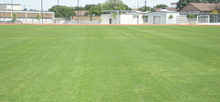Maintaining sports fields in South Texas has had many challenges especially in the past couple of years. Beginning with the end in mind is one of the best approaches to developing a maintenance program. The program can be a little maintenance as possible to Major League/NFL/MLS caliber or somewhere in between depending on what your end users are looking for.
The end in most cases is a field that the ball rolls well with an even appearance. This even appearance starts with mowing. Mowing, when done correctly and often, will produce surfaces that provide for that even appearance and a consistent ball roll no matter the type of grass. Mowing helps reduce weeds or their appearance promotes lateral growth and produces a dense wear tolerant field. By mowing to remove no more than one-third of the leaf should be the target. Simply put if our preferred height is 2” then we mow when the grass gets to 3”. Turfgrass under normal growing conditions usually grows one-fourth of an inch a day. In our example, four days after mowing the turfgrass would need to be cut. As we go shorter in mowing height the time between mowing is reduced. In Texas, we deal primarily with Bermuda grass sports fields. The ideal height for a sports field with Bermuda is approximately 1”. At that height mowing should be done at least two times a week if not three. Unfortunately, mowing gets shorted in our programs. Because in the grand scheme of things mowing costs. It costs us time which we seemed to be short on these days, but it also costs money in equipment, fuel, and labor.
Now there is more to sports field maintenance than mowing. There is irrigation, aerification, topdressing, fertility, and pest management. All of these will be discussed in the future, but building a maintenance program starting with mowing correctly and often will make the end result much easier to attain once all other parts of the program or implemented.

